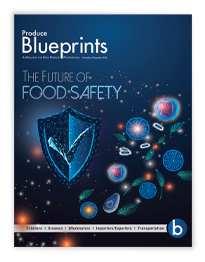In 1914 poet Carl Sandburg described his adopted town of Chicago as the “city of the broad shoulders,” referring to the commercial and industrial vigor of the U.S.’s third-largest city. The description is no less true today as Chicago enjoys the combined benefits of a Midwestern setting, great infrastructure (including six interstate highways that connect both east and west for 2,000 miles), and a prime location on Lake Michigan.
Chicago continues to evolve from a legendary meat-and-potatoes region to a culinary promised land. Along with the area’s vibrant diversity and being within a day’s drive of 70 percent of the country’s population, it’s a formula that places the Chicago International Produce Market (CIPM) at the heart of the expanding produce industry within the Midwest and nation.
While Chicago is a city full of culture, superb dining, and a hub of commerce and innovation—one inescapable feature is the weather. The brutal, arctic winters and steamy, sweltering summers not only present challenges for preserving the quality of fresh produce, but consumer behavior can be greatly affected by fluctuating temperatures, both high and low.
Weather Extremes
A number of sources discussed how during the harshest parts of the winter sales often slow down, and there are gaps in supply that can cause prices to rise. A recent case in point was tomatoes.
Mark Pappas, president of Coosemans Worldwide, Inc., a specialty distributor and importer on the CIPM for nearly 25 years observes, “The gap in hydroponic tomatoes was bigger this year,” he confirms. “Prices have been up and it was tough to source some items. Canadian hothouses were retooling just as there were less than ideal conditions in Texas and Mexico. All varieties of tomatoes were expensive. We’ve seen spikes before, but this year they stayed up longer than in previous years.” The upside, he notes is that the pricing spikes rarely last. “In spring, everything is more plentiful and prices come down.”
Longtime wholesaler Nick Gaglione, president of Dietz & Kolodenko Comp-any, a receiver and distributor located at the CIPM, comments, “If people stay at home due to extreme weather, they’re not buying as much. On the other hand, the early winter of 2015 was mild, so people were doing things other than shopping for groceries, purchasing more prepared foods from service delis. Instead of buying five pounds of potatoes from the produce department, they would buy a pint of roasted potatoes.”
The CIPM, which opened at its current location in 2001 and is home to around 20 vendors, recently addressed Chicago’s extremes in weather by adding an enclosure around the main dock. This not only helps reduce costs by maintaining temperatures in the loading area—during the heat and humidity of the summer and bone-chilling cold of the winter—but can also minimize losses and shrink of the many perishables stored inside.
Labor Pains
Unions play a big role in Chicago commerce, and this can present challenges to produce vendors on the Market.
The playing field, especially when it comes to hourly wages, is uneven as nonunion workers reportedly earn $18 an hour while union wages are in the range of $30 per hour. For an industry with razor-thin margins, the impact can be staggering.
A related facet of labor concerns transportation and the ongoing hours of service wrangling between drivers and federal authorities. Limits and fewer hours behind the wheel can turn a routine or typical three-day haul into four or more days, especially with the vagaries of Chicagoland’s legendary traffic snarls.
Several of Chicago’s main arteries were among the American Transportation Research Institute’s “Congestion Impact Analysis” in 2015, including the I-290 interchange at I-94 (ranked second in the nation out of 250 total locations), as well as I-94’s interchanges with I-80 and I-90 going into the city. Fortunately, the CIPM is just off I-55, so most drivers aren’t forced to navigate through all the most congested routes.



